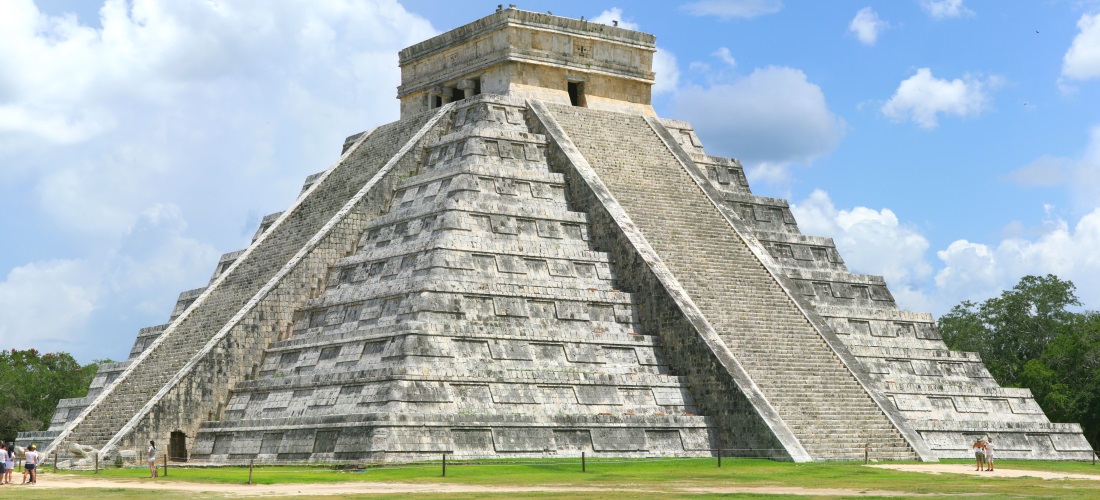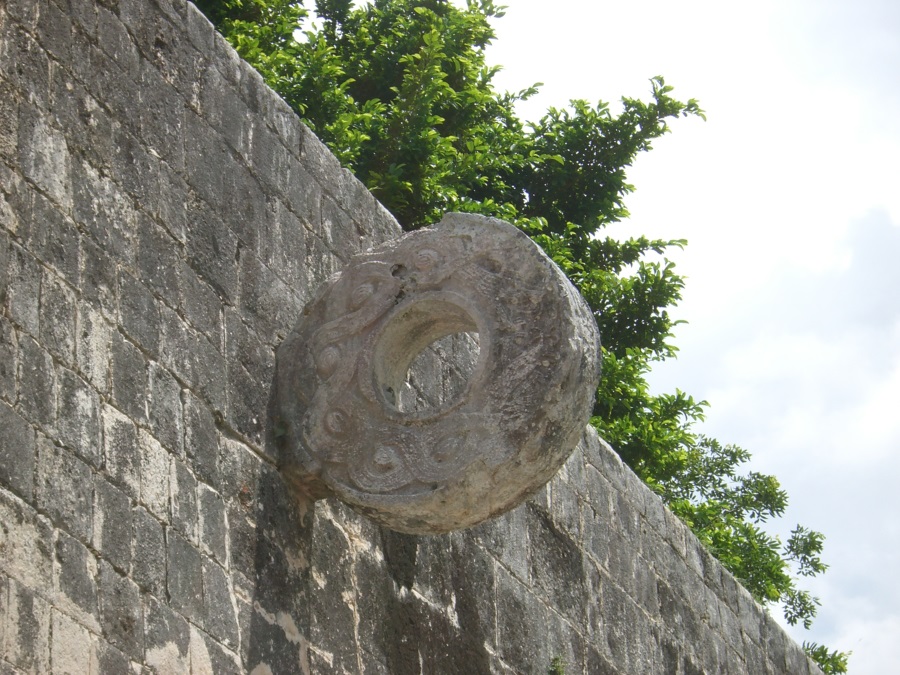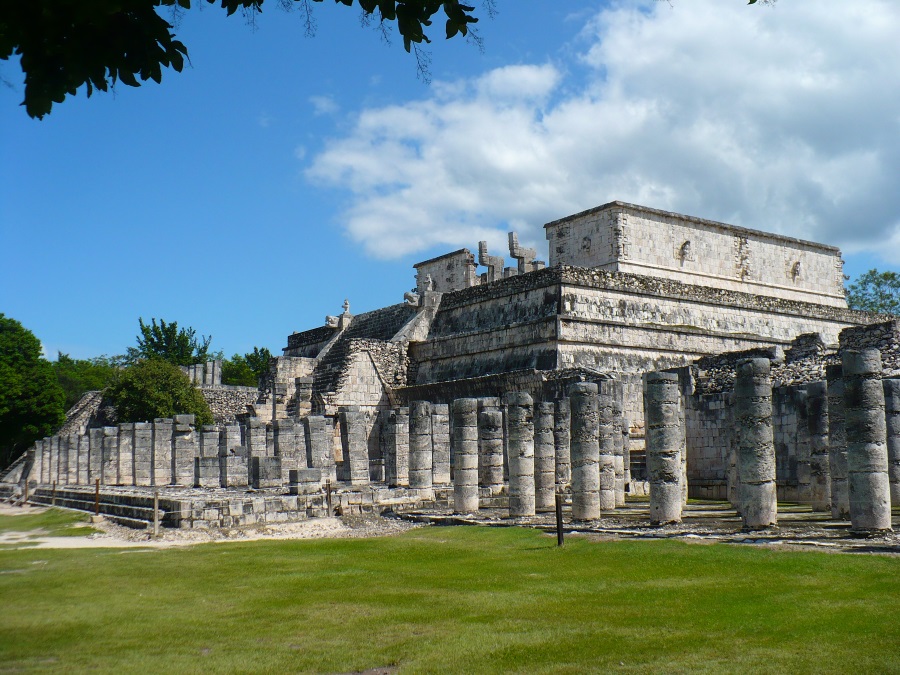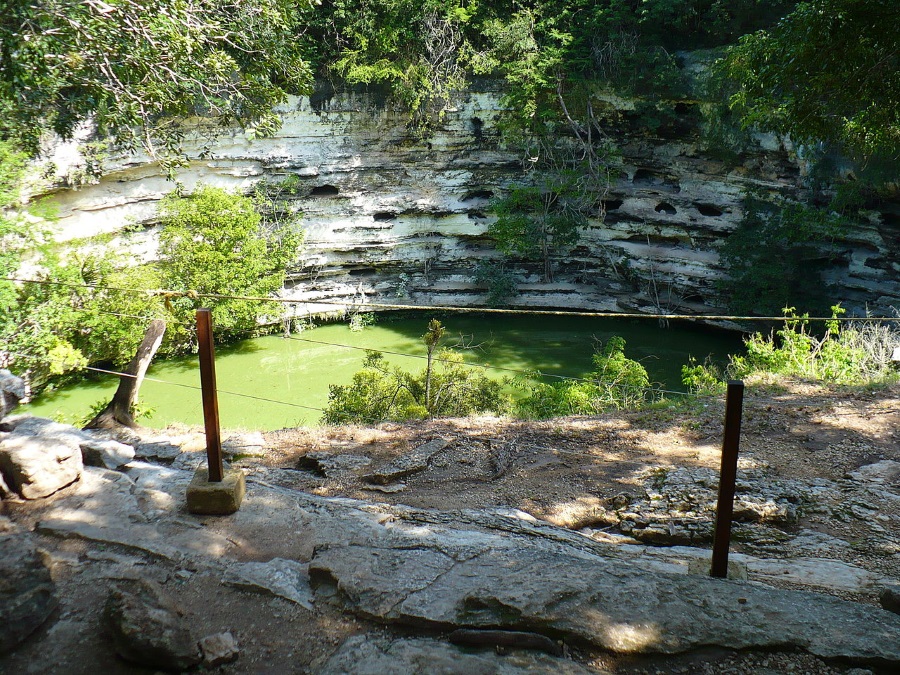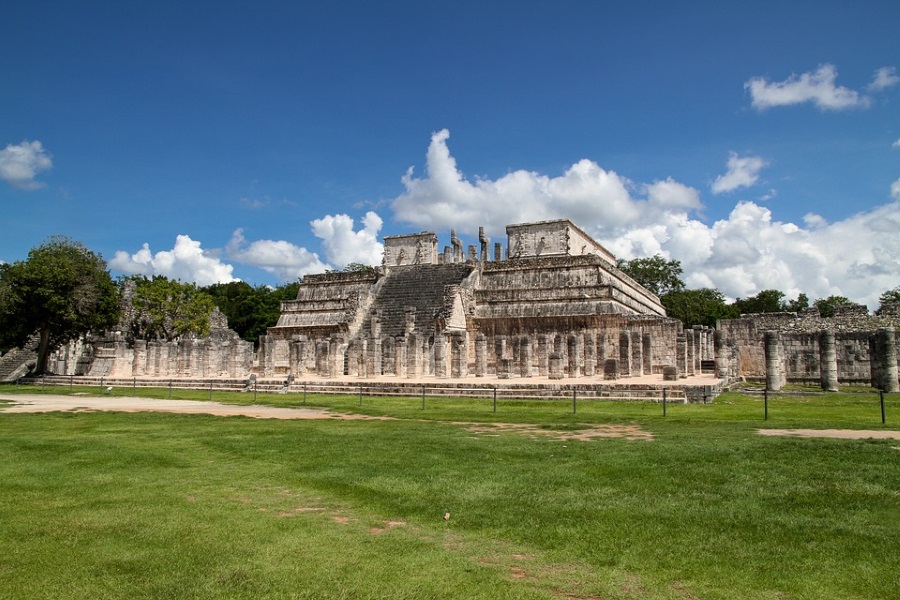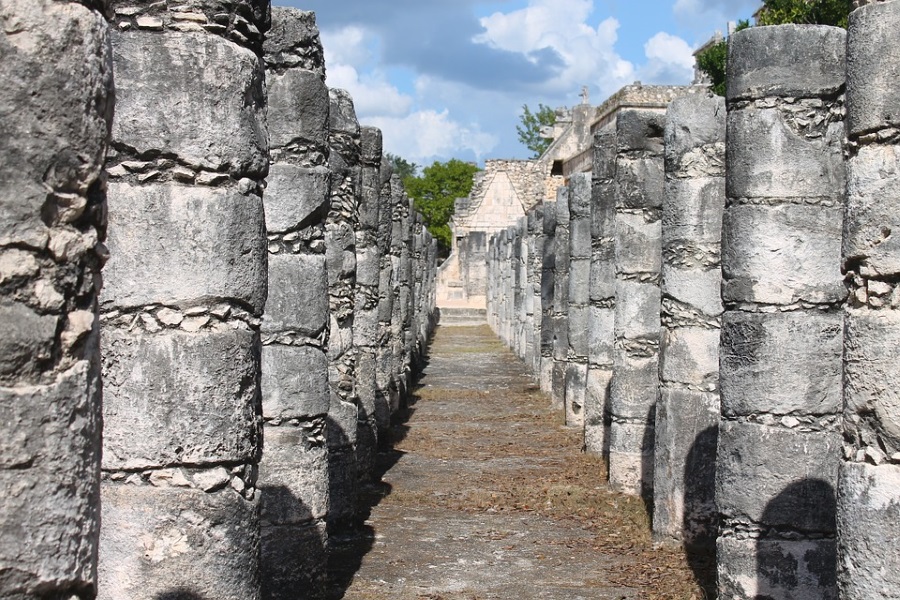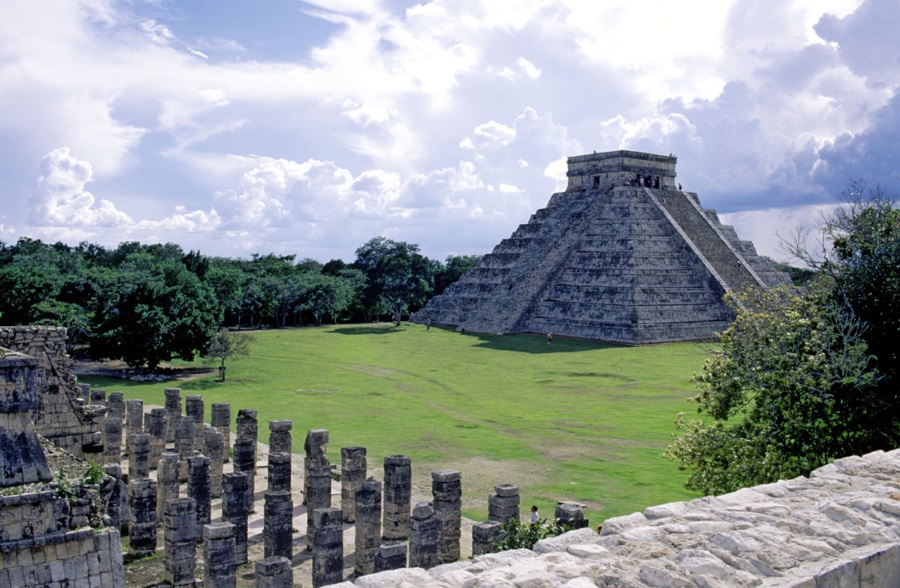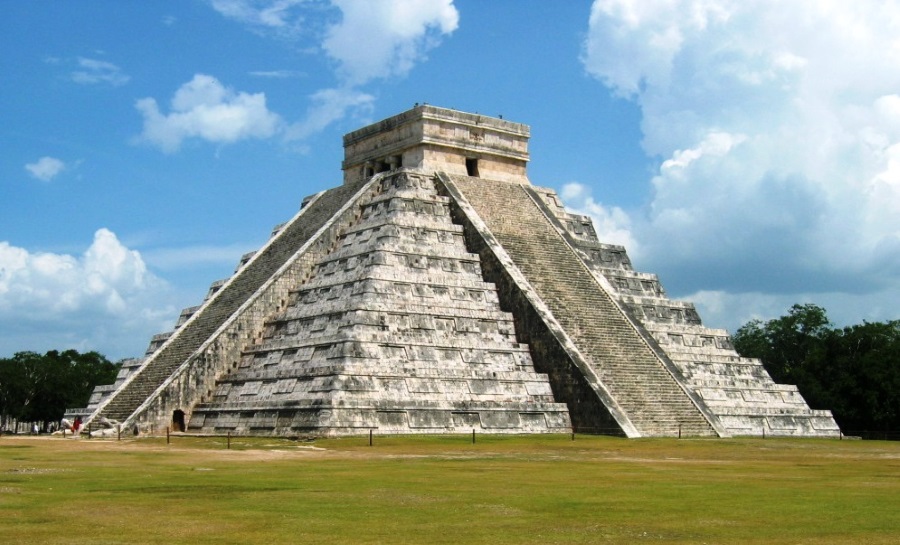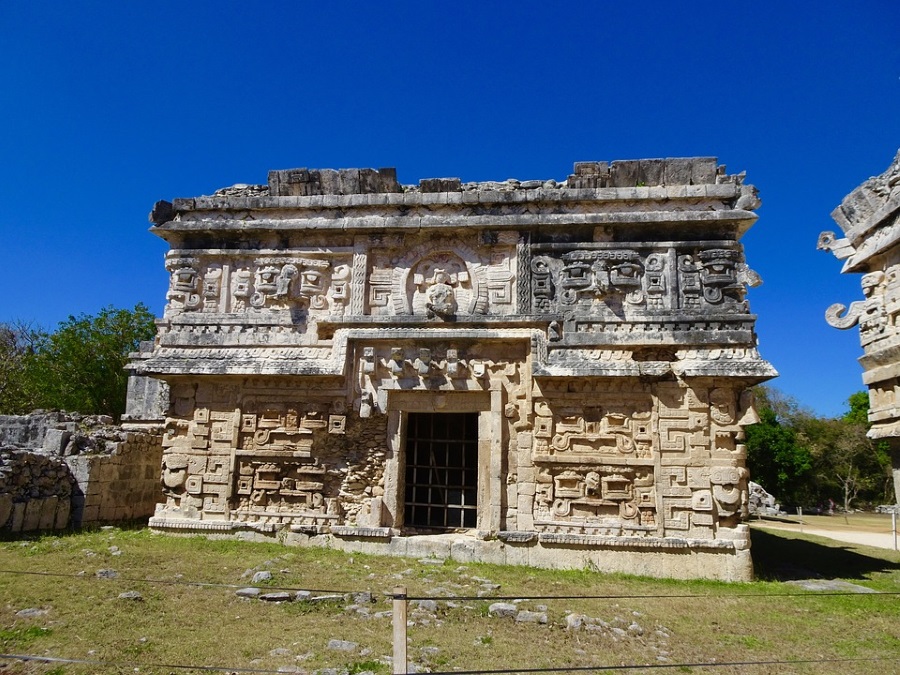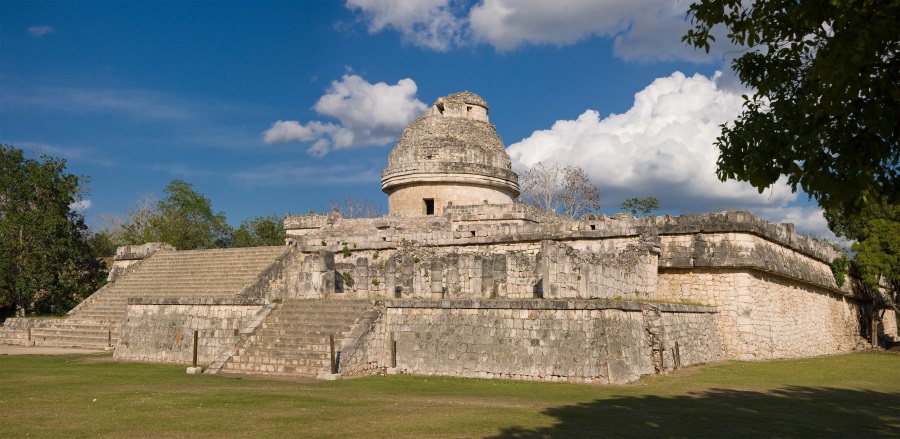Chichen Itza
Chichen Itza “at the mouth of the well of the Itza people”. Chichen Itza, one of The Seven Wonders of the Modern World, is an archeological park, was a center of commercial and religious power, nowadays considered one of the most important vestiges of pre-Hispanic Mexico. Chichen Itza is located in Yucatan Peninsula, specifically in Yucatan state, 3 km from the small town of Pisté and 80 minutes from Merida city. Chichen Itza is one of the most visited archaeological sites in Mexico; an estimated 1.4 million tourists visit the…
Chichen Itza "an der Mündung des Brunnens der Itza".
Chichen Itza, eines der sieben Weltwunder der Moderne, ist ein archäologischer Park, ein Zentrum kommerzieller und religiöser Macht, das heute als eines der wichtigsten Überreste des vorspanischen Mexikos gilt. Das Chichen Itza befindet sich auf der Halbinsel Yucatan, speziell im Bundesstaat Yucatan, 3 km von der kleinen Stadt Pisté und 80 Minuten von der Stadt Merida entfernt.
Chichen Itza ist eine der meistbesuchten archäologischen Stätten in Mexiko. Schätzungsweise 1,4 Millionen Touristen besuchen jedes Jahr die Ruinen. Es war eine der größten Maya-Städte und es war wahrscheinlich eine der mythischen Großstädte. Die Stadt hatte möglicherweise die unterschiedlichste Bevölkerung in der Maya-Welt, ein Faktor, der zur Vielfalt der Architekturstile an der Maya beigetragen haben könnte Standort, der viele schöne Steingebäude in verschiedenen Erhaltungszuständen enthält, und viele wurden restauriert.
Bewundern Sie sich mit der Pyramidenburg des Maya-Schlangengottes Kukulkan und entdecken Sie die Traditionen, Geheimnisse und Wunder der Maya-Kultur. Machen Sie eine Führung durch die imposanten Überreste der Maya, die für ihre mathematische Präzision bekannt sind.
Die drei bekanntesten dieser Komplexe sind:
![]() The Great North Platform, which includes the monuments of El Castillo, the Temple of Warriors and the Great Ball Court.
The Great North Platform, which includes the monuments of El Castillo, the Temple of Warriors and the Great Ball Court.
![]() The Osario Group, with the Osario Pyramid and the Temple of Xtoloc.
The Osario Group, with the Osario Pyramid and the Temple of Xtoloc.
![]() The Central Group, integrated by the Caracol, Las Monjas and Akab Dzib.
The Central Group, integrated by the Caracol, Las Monjas and Akab Dzib.
Nachdem Sie die Maya-Strukturen erkundet haben, können Sie auch die „Heilige Blaue Cenote“ in Ik Kil, dem „Ort der Winde“, besuchen und sich im kristallklaren Wasser dieses natürlichen Brunnens in einer Höhle mit üppiger Vegetation erfrischen.
Information
-
AbfahrtCancun / Riviera Maya
El Castillo
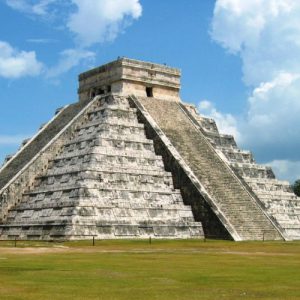 Also known as the Temple of Kukulkan a step pyramid stands about 30 meters high and consists of a series of nine square terraces, each approximately 2.57 meters high, with a 6 meters high temple upon the summit. On the Spring and Autumn equinoxes, in the late afternoon, the northwest corner of the pyramid casts a series of triangular shadows against the western balustrade on the north side that evokes the appearance of a serpent wriggling down the staircase, which some scholars have suggested is a representation of the feathered-serpent god Kukulkan.
Also known as the Temple of Kukulkan a step pyramid stands about 30 meters high and consists of a series of nine square terraces, each approximately 2.57 meters high, with a 6 meters high temple upon the summit. On the Spring and Autumn equinoxes, in the late afternoon, the northwest corner of the pyramid casts a series of triangular shadows against the western balustrade on the north side that evokes the appearance of a serpent wriggling down the staircase, which some scholars have suggested is a representation of the feathered-serpent god Kukulkan.
The principal pyramid of Chichen Itza archeological Site | Recognized as one of The Seven Wonders of the Modern World | Part of the The Great North Platform Group
Temple of Warriors
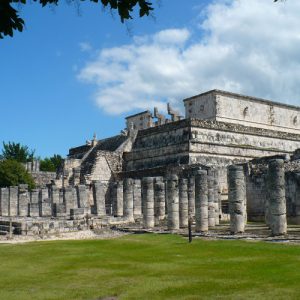 The Temple of the Warriors complex consists of a large stepped pyramid fronted and flanked by rows of carved columns depicting warriors. This complex is analogous to Temple B at the Toltec capital of Tula, and indicates some form of cultural contact between the two regions. This temple encases a former structure called The Temple of the Chac Mool which is at the top of the stairway on the pyramid’s summit.
The Temple of the Warriors complex consists of a large stepped pyramid fronted and flanked by rows of carved columns depicting warriors. This complex is analogous to Temple B at the Toltec capital of Tula, and indicates some form of cultural contact between the two regions. This temple encases a former structure called The Temple of the Chac Mool which is at the top of the stairway on the pyramid’s summit.
Part of the The Great North Platform Group
The Great Ball Court
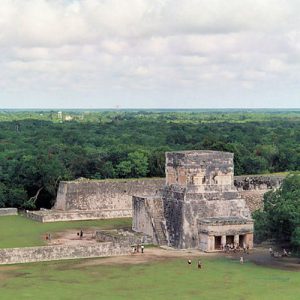 About 150 meters to the north-west of the Castillo is the largest and best preserved ball court in ancient Mesoamerica, measures 168 by 70 meters. The parallel platforms flanking the main playing area are each 95 meters long. The walls of these platforms stand 8 meters high; set high up in the center of each of these walls are rings carved with intertwined feathered serpents. At the base of the high interior walls are slanted benches with sculpted panels of teams of ball players; in one panel, one of the players has been decapitated; the wound emits streams of blood in the form of wriggling snakes.
About 150 meters to the north-west of the Castillo is the largest and best preserved ball court in ancient Mesoamerica, measures 168 by 70 meters. The parallel platforms flanking the main playing area are each 95 meters long. The walls of these platforms stand 8 meters high; set high up in the center of each of these walls are rings carved with intertwined feathered serpents. At the base of the high interior walls are slanted benches with sculpted panels of teams of ball players; in one panel, one of the players has been decapitated; the wound emits streams of blood in the form of wriggling snakes.
Part of the The Great North Platform Group
The Osario Pyramid
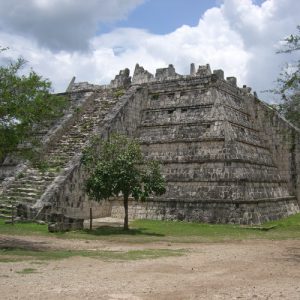 The Osario itself, like El Castillo, is a step-pyramid temple dominating its platform, only on a smaller scale, which appear to be oriented toward the second largest cenote at Chichen Itza, Xtoloc. Like its larger neighbor, it has four sides with staircases on each side. There is a temple on top, but unlike El Castillo, at the center is an opening into the pyramid which leads to a natural cave. Archaeologists today believe neither that the structure was a tomb and that the personages buried in it were priests.
The Osario itself, like El Castillo, is a step-pyramid temple dominating its platform, only on a smaller scale, which appear to be oriented toward the second largest cenote at Chichen Itza, Xtoloc. Like its larger neighbor, it has four sides with staircases on each side. There is a temple on top, but unlike El Castillo, at the center is an opening into the pyramid which leads to a natural cave. Archaeologists today believe neither that the structure was a tomb and that the personages buried in it were priests.
Part of The Osario Group
The Caracol
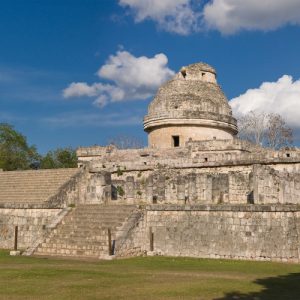 It is a round building on a large square platform, gets its name from the stone spiral staircase inside. The structure, with its unusual placement on the platform and its round shape is theorized to have been a proto-observatory with doors and windows aligned to astronomical events, specifically around the path of Venus as it traverses the heavens.
It is a round building on a large square platform, gets its name from the stone spiral staircase inside. The structure, with its unusual placement on the platform and its round shape is theorized to have been a proto-observatory with doors and windows aligned to astronomical events, specifically around the path of Venus as it traverses the heavens.
Part of The Central Group
Las Monjas
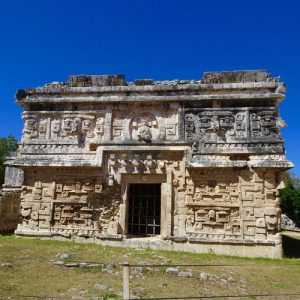 A complex of Terminal Classic buildings constructed in the Puuc architectural style; distinguished by its concentration of hieroglyphic texts dating to the Late to Terminal Classic. The Spanish named this complex Las Monjas but it was actually a governmental palace, just to the east is a small temple decorated with elaborate masks.
A complex of Terminal Classic buildings constructed in the Puuc architectural style; distinguished by its concentration of hieroglyphic texts dating to the Late to Terminal Classic. The Spanish named this complex Las Monjas but it was actually a governmental palace, just to the east is a small temple decorated with elaborate masks.
Part of The Central Group
Sacred Blue Cenote
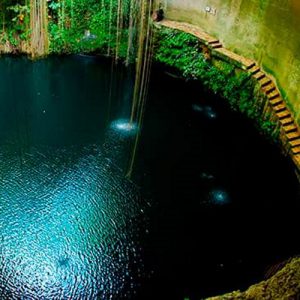 The Yucatan Peninsula is a limestone plain, with no rivers or streams. The region is pockmarked with natural sinkholes, called cenotes, which expose the water table to the surface. One of the most impressive of these is the "Cenote Sagrado", which is 60 metres in diameter and surrounded by sheer cliffs that drop to the water table some 27 metres below. The Cenote Sagrado was a place of pilgrimage for ancient Maya people who, according to ethnohistoric sources, would conduct sacrifices during times of drought. Archaeological investigations support this as thousands of objects have been removed from the bottom of the cenote, including material such as gold, carved jade, copal, pottery, flint, obsidian, shell, wood, rubber, cloth, as well as skeletons of children and men.
The Yucatan Peninsula is a limestone plain, with no rivers or streams. The region is pockmarked with natural sinkholes, called cenotes, which expose the water table to the surface. One of the most impressive of these is the "Cenote Sagrado", which is 60 metres in diameter and surrounded by sheer cliffs that drop to the water table some 27 metres below. The Cenote Sagrado was a place of pilgrimage for ancient Maya people who, according to ethnohistoric sources, would conduct sacrifices during times of drought. Archaeological investigations support this as thousands of objects have been removed from the bottom of the cenote, including material such as gold, carved jade, copal, pottery, flint, obsidian, shell, wood, rubber, cloth, as well as skeletons of children and men.
Swimming is allowed
Tour Location
Chichen Itza, Yucatan

